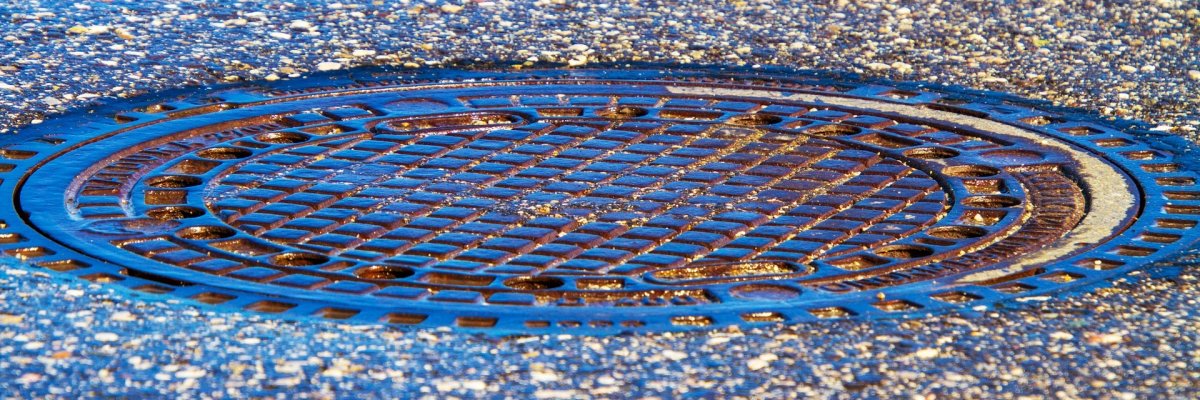Rainwater
The rainwater that accumulates on the properties can be drained in different ways. It can be connected to the public sewer system via a sewer connection, discharged into an adjacent body of water or allowed to seep away on the property. There are different things to consider for each type of drainage. The sewer connection is the most common option. The rainwater is fed into the public sewer and from there collected and transported to a rainwater retention basin, a body of water or, in mixed water areas, to a sewage treatment plant. The discharge into a body of water must be applied for under water law at the lower water authority of the Kleve district. This authority decides in each individual case whether a discharge can be approved or not. There are various options for infiltrating rainwater.
Surface infiltration
Surface infiltration of rainwater can be used if small areas such as garden sheds, small patio or courtyard roofs or similar are to be drained. In this case, the rainwater is allowed to seep into green areas or planting beds on the property via the living soil zone. It is not surface infiltration if the rainwater is directed onto a paved area that is connected to the rainwater drain with an ACO drainage channel or similar. In this case, the roof surface is considered to be connected to the sewer. The disadvantage of surface infiltration is the large amount of space required. Care must be taken to ensure that neighboring properties are not waterlogged. This type of infiltration does not require a permit and only needs to be reported to the Kevelaer public utility company.
Infiltration troughs
Infiltration troughs are suitable for the infiltration of medium-sized areas such as house roofs, garage roofs and patio roofs. The rainwater is collected in a depression (trough) and allowed to seep away via the living soil zone. The space required or the size of the depression depends on the soil conditions and the connected area. As a rough guide, 10 to 20 % of the connected area should be used. For private construction projects with a connected area of up to 499 m², the swale is approved by the municipal utilities. For commercial and industrial construction projects as well as private projects with a connected area of 500 m² or more, the lower water authority of the Kleve district will approve the swale.
Swale infiltration trenches
Infiltration trench systems are infiltration trenches filled with coarse gravel with a trough on top. Like simple swales, they are suitable for the infiltration of medium-sized areas. The advantage of a swale-trench system is that water is temporarily stored in both the swale and the trench. In addition, the coarse gravel achieves a better infiltration capacity in the soil. They also require less space than simple swale infiltration systems. As a rough guide, 5 to 15% of the connected area should be used. A trough infiltration system must be approved by the Kevelaer public utility company.
Infiltration trenches
Infiltration trenches are underground infiltration trenches filled with coarse gravel. In contrast to swale infiltration systems, the filtration effect of the active soil layer and the storage volume of the swale are absent here. The advantage is that no land is required. However, due to the reduced filtering effect of infiltration trenches, a greater distance to the aquifer must be maintained. Infiltration trenches must be approved by the lower water authority of the district of Kleve.
Shaft seepage
Shaft infiltration systems are only rarely applied for and approved. The selective discharge of precipitation water into the groundwater is only possible in a few cases. The construction of shaft infiltration systems is quite complex. In addition, the storage volume is very limited. Soakaway shafts must be approved by the lower water authority.
Rainwater utilization
Using rainwater on your own property is another option for rainwater drainage. The water is collected in storage tanks (rain barrels or similar) or underground cisterns. The collected water can be used for watering the garden. In the case of cisterns, it can also be used for flushing toilets. However, it must be ensured that there is no connection to the public water supply. In any case, the storage tanks must have overflows. These can either be connected to the public sewage system or to one of the aforementioned infiltration systems. If the rainwater is used for drainage objects with a sewer connection, a water meter must also be installed. Rainwater harvesting systems must be registered with Stadtwerke Kevelaer.
| Drainage type | What speaks for it: | What speaks against it: |
|---|---|---|
| Duct connection |
|
|
| Surface Infiltration |
|
|
| Swale infiltration |
|
|
| Trough trenches |
|
|
| Infiltration trenches |
|
|
| Shaft infiltration |
|
|
| Rainwater utilization |
|
|
| Water discharge |
|
|
